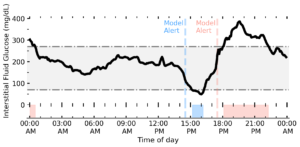 COTADS project blog by Chris Duckworth
COTADS project blog by Chris Duckworth
Research Engineer at the IT Innovation Centre | University of Southampton
Chronic medical conditions, such as type-1 diabetes (T1D), place a significant emotional and physical burden on individuals and their families. People with T1D face a daily balance to keep their blood glucose levels within safe levels (i.e., in-range), with risk of severe complications common if they do not.
Artificial Intelligence (AI) powered technology has the potential to help. One key goal of AI in healthcare is to help streamline care and identify risks in the management of chronic conditions. To date, however, the adoption of AI is limited, as the technology often fails to be transparent or does not effectively engage users.
To build technology that engages users, we need to engage those users in technology development.
In COTADS (COdesigning Trustworthy Autonomous Diabetes Systems) we bring together people with T1D and their caregivers, clinicians, and data scientists to develop AI solutions for T1D through codesign. Here we follow the development of a machine learning model in this process from the perspective of a data scientist participating in the design team.
Role of the data scientist
“A data scientist is someone who creates programming code, and combines it with statistical knowledge to create insights from data.” [Harvard Business Review, 2016]
In other words, a data scientist is the one responsible for creating the machine learning models, which use data to provide insight and make predictions.
Let us consider an example model for T1D. Below shows the blood glucose levels (black line) of a young adult with T1D tracked by a Continuous Glucose Monitor (CGM) device throughout the day. The grey shaded region shows the ‘safe’ range to keep blood glucose levels between.

Machine learning models can make use of this data to predict ahead-of-time when a person with T1D will go below (blue) and above (red) this range. The dashed vertical lines show when the model first made an alert, and the shaded regions underneath show when the person is outside of the range. This model could therefore give insight into when exactly a person needs to be proactive about their blood glucose level.
Codesign for data science
In COTADS, codesign facilitated discussion between young adults with T1D and their caregivers, clinicians, human-computer interaction experts and data scientists to explore unmet care needs and to understand how AI could help.
Let’s try to rewrite the definition from above with codesign in mind:
“A data scientist should be someone who creates programming code, helps others understand it, and through mutual learning create insights from data that are effective.”
In other words, while a data scientist is the one responsible for creating the machine learning models, they should be iteratively shaped by the needs of the people who are expected to use the models to support their lives.
Shaping machine learning models
Revisiting our machine learning model with everyone in the room not only enabled mutual learning, but fully shaped its purpose. Without context, alerts may seem important for managing risk. However, the reality is that people with T1D and clinicians are already overwhelmed both with data, and alerts, leading to fatigue and burnout.
Through codesign it became clear that the utility of this model is better used to summarise an individual’s data and explain how they can reduce their risk. In COTADS we have been working with explainable AI to develop technology that can provide automated feedback on why the alerts are occurring and help reduce the emotional burden of T1D.